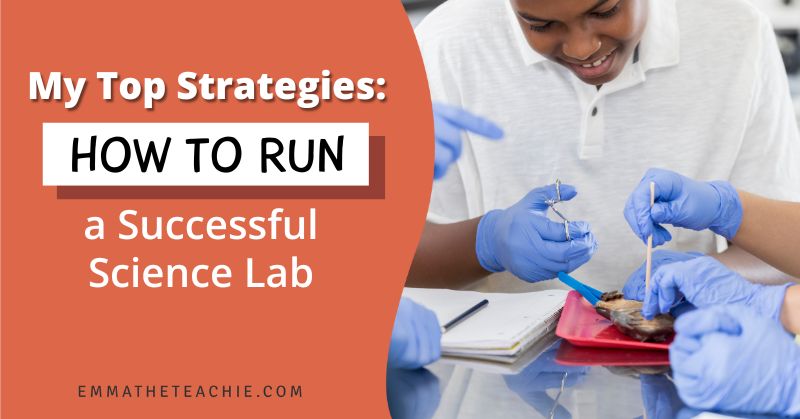
7 Valentine’s Day Science Activities for Middle School
Valentine’s Day is coming up, and you betcha I love using some love-themed activities in my science lessons!
If you are struggling to come up with ideas to celebrate Valentine’s Day with your students, I’ve got you covered.
In this post, I’m going to share 7 Valentine’s Day science activities you can use with your middle schoolers! Some of these will also work for high school students.
These activities are perfect for linking science and love – arguably the two best things in the world!
(Ok ok, that’s a little cheesy, I know…)
Ready?! Let’s get started!
1 – Heart rate lab

Ah yes, the body’s most romantic muscle – the heart!
You can run a heart rate lab with very little prep. Ask students to predict heart rates after different types of exercise, and then to design their own experiment to test this.
Some easy ideas:
- Press-ups
- Star jumps
- Sit-ups/crunches (ideally with an exercise mat on the floor)
- Bicep curls (use water bottles or textbooks as the weights)
- Standing-up and sitting-down in their chair
Think about which exercises you can accommodate in your classroom, or maybe you have access to outdoor space! If you are limited in time, you can choose to just do 2 or 3 exercises.
Some control variables to consider:
- Length of exercise
- Resting heart rate before exercise
This lab will have your students active in their learning! It may also bring out some competitiveness in the athletes in your class – you have been warned!
2 – Study the mating rituals of birds
Birds of paradise are captivating. The males have displays for attracting females that are both hilarious and very impressive!
The video above shows the extraordinary courtship display put on by the Western parotia. It is sure to get a laugh from your students!
This can be a great one-period project – put students into groups and ask them to research one bird of paradise. They can create a poster or presentation about their bird to display to the class.
You can also use the video as a prompt for a discussion around evolution and courtship behaviors. Discuss why birds of paradise are sexually dimorphic, and if students know any other species that are like this.
3 – Create Valentine’s Day lava lamps
Creating lava lamps is always a fun and easy activity to do with your students. By using some red food coloring and pink or red glitter, we can make them Valentine’s themed!
There are loads of ways to do this, but here are the basic supplies you will need:
- Small jars or glasses or bottles
- Vegetable oil
- Water (you can also use vinegar for a more vigorous reaction)
- Baking soda or Alka-Seltzer tablets
- Red food coloring
- Glitter (optional)
- Torch (optional)
Scientific American has a great method and explanation of the science behind these homemade lava lamps!
4 – A Valentine’s Day science crossword

This is a short but sweet Valentine’s Day activity for your science lesson!
The best thing about it? You can get it for free here!
Science and love are linked together with these crossword puzzle clues. Your students will have fun working out the answers. Once finished, they can color in the pictures, or add their own clues.
If you are teaching a normal lesson on Valentine’s Day, this is also great for early finishers.
Simply print a class set and you are ready to go!
Download this fun Valentine’s science crossword puzzle when you join my mailing list!
Woohoo!
Your crossword puzzle is on its way to your inbox!
5 – Grow heart shaped crystals
Growing crystals is a popular STEM experiment. Students are so excited to come back into class and see how much their crystals have grown!
You can give this experiment a Valentine’s Day twist by making heart shaped crystals.
Here are the basic supplies you will need:
- Borax (usually found by the laundry detergent)
- Water
- Pipe cleaners – pink or red
- String or fishing line
- Pencils or wooden skewers
- Large pots
And here is a great crystal hearts blog post with the method and lovely photos of the results.
If you want to introduce some variables to this experiment, you can change the rate of cooling!
Fill a sink or basin with a few inches of almost boiling water, and place some of the pots of crystals to cool down in there. Let the others cool at room temperature, and compare.
Hint: the slower the crystals cool down, the bigger they will be!

6 – Study the hormones of love
Let students research the link between chemistry and love! Students are always curious about hormones (I mean… they have a lot of them right?!)
This Valentine’s Day, ask your students to research the love hormone oxytocin.
Here are some prompts:
- Where is oxytocin produced
- What is its effect in the body
- Which activities cause its release
- The role of oxytocin in child-birth
- Comparison of oxytocin to dopamine and serotonin
Learning about hormones is great for upper middle school and high school students. And they can produce a group presentation or poster to summarize their research!
7 – A heart dissection

If you are able to run a heart dissection, this is certainly one lesson that your students won’t forget!
You can use pig hearts or sheep hearts for this, and run it as a demonstration, or let students dissect their own hearts.
Now, this is a fairly difficult dissection – if students are dissecting their own heart, they will need clear guidance.
I like to demonstrate one part of the dissection and then walk around to support students, before moving onto the next part of the dissection. This helps students feel confident in orienting their heart and making the correct incisions.
Here are some useful resources for you:
This is a really engaging lesson for students! For those that don’t want to/can’t take part in the dissection, they can make a 3D model of the heart using modeling clay.
Did you find a Valentine’s Day science activity?
I hope this list gave you some ideas for how to celebrate Valentine’s Day with your students!
If you don’t have time to plan a big activity, or don’t have the budget for materials, then I’ve got you covered.
This is super easy to use – all you need to do is download and print it!
Share the love with your teacher bestie – send them this blog post, or the link to get their own copy of my Valentine’s Day science crossword puzzle!
I hope you have a lovely Valentine’s Day,
P.S. Don’t forget to get your Valentine’s Freebie right here!



